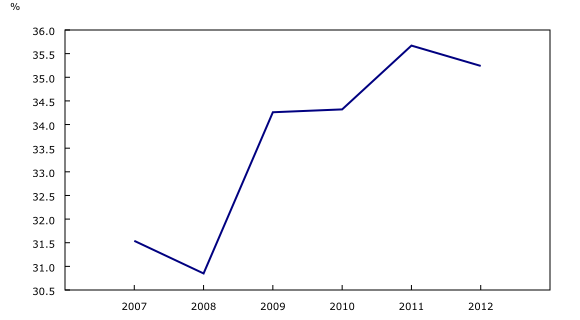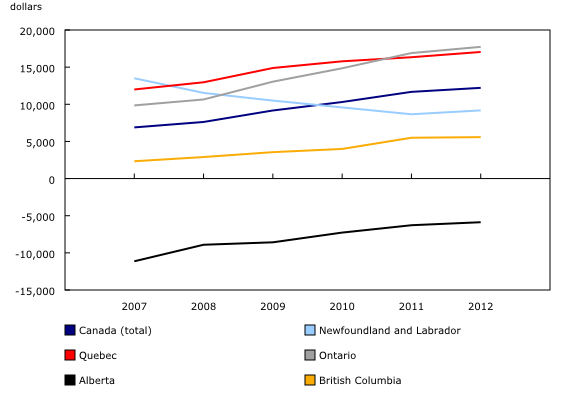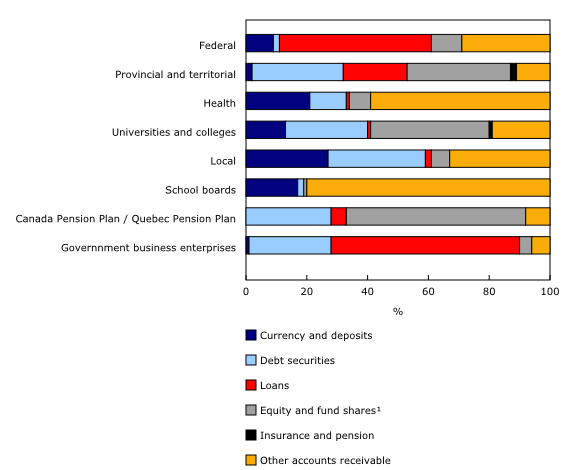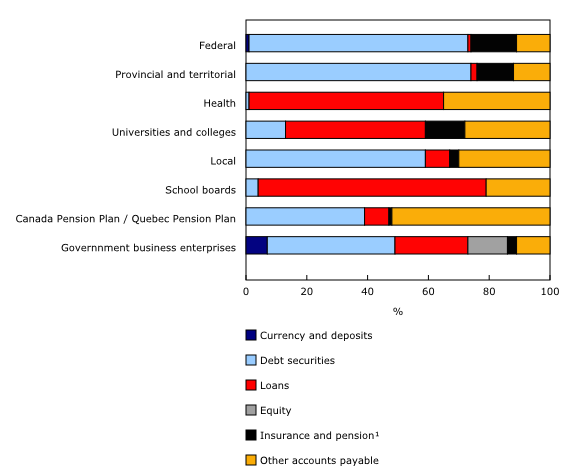Canadian Government Finance Statistics: Financial flows and balance sheet, 2007 to 2012 (provisional)
Archived Content
Information identified as archived is provided for reference, research or recordkeeping purposes. It is not subject to the Government of Canada Web Standards and has not been altered or updated since it was archived. Please "contact us" to request a format other than those available.
Released: 2015-02-04
Provisional estimates of the Canadian Government Finance Statistics (CGFS) for financial flows and the balance sheet of the general government and government business enterprises are now available for the period 2007 to 2012.
A new study, "Provisional estimates of the Canadian Government Finance Statistics (CGFS): financial flows and balance sheet," is now available in Latest Development in the Canadian Economic Accounts (Catalogue number13-605-X).
This release, the last of a series of three, follows the two previous releases in November 2014 on the statement of operations and functional expenses for all components of general government, as well as federal and provincial and territorial government business enterprises.
The data sources, methods and concepts that underlie the CGFS-based data depart significantly from those of the Financial Management System-based data previously published by Statistics Canada.
Given the magnitude of these differences, Statistics Canada has decided to release the data with the provisional qualifier. This qualifier signals to users that although the data are fit for use, they are subject to revisions. Over the current year, these data will be integrated into the rest of the Canadian System of Macroeconomic Accounts (the national accounts, balance of payments, international investment position, input-output tables), resulting in revisions as data, concepts and methods are reconciled and aligned within the national accounts framework.
The data will retain their provisional status until a number of improvements are implemented over the current year. These improvements include balancing grants across levels of government, adding capital expenditures and capital stock, as well as consolidation of inter-sector transactions and stock positions.
While some of the detailed series will be revised over the current year and some data gaps will remain, the general story and trends found in the current data will remain similar.
The federal government's net liabilities as a percentage of gross domestic product increases from 2008 to 2012
Net financial worth is among the most important analytic measures in the CGFS framework. Net financial worth is defined as the total value of financial assets minus the total value of outstanding liabilities. When financial assets are greater than liabilities the measure is referred to as net financial assets. When liabilities are greater than financial assets the measure is referred to as net liabilities.
The federal government's net liabilities as a percentage of gross domestic product (GDP) stood at 30.9% in 2008, but grew rapidly in 2009 to 34.3%. Despite strong economic growth in 2010 and 2011, this ratio grew steadily, peaking at 35.7% in 2011. However, in 2012, the ratio fell slightly to 35.2% as federal government net liabilities grew at a slower pace than GDP.
Between 2007 and 2012, the federal government's net liabilities grew by $149 billion to reach $649 billion. This increase was outpaced by growth in provincial and territorial governments' net liabilities, which rose by $200 billion. By 2012 provincial and territorial governments' net liabilities stood at $428 billion.
One way to compare the provincial and territorial financial position is to look at net liabilities on a per capita basis. The net liabilities per capita picture for provincial and territorial governments changed significantly after the 2008 global financial crisis. In 2012, Ontario posted the highest net liability position per capita, rising from $9,849 in 2007 to $17,734 in 2012, an increase of 80.1%. Alberta, Yukon, Northwest Territories and Nunavut were the only jurisdictions to record a per capita net financial asset position.
In 2007, the highest net liability position per capita among provincial and territorial governments was recorded by Newfoundland and Labrador at $13,505, followed by Quebec at $11,992. In 2012, the net liability position per capita of Newfoundland and Labrador ranked seventh, at $9,175 dollars, a 32.1% decline compared with 2007.
In 2007, Alberta recorded a net financial asset position of $11,134 per capita. By 2012, the net financial asset position per capita had dropped to $5,874, a decrease of 47.2%. A large increase in debt securities liability was one of the main contributors to the change over this period.
Financial assets and liabilities
The roles, responsibilities and powers of each level of government are reflected in the composition and evolution of their financial assets and liabilities.
The financial assets of the federal government and government business enterprises are mainly composed of loans, particularly to corporations.
There is preponderance in equity and investment fund shares and debt securities for the Canada and Quebec Pension Plans and for the provincial and territorial governments. In fact, these sectors of government manage important social security funds requiring the creation and administration of assets offering higher potential returns. Assets held by universities and colleges in endowment funds are also, for the most part, composed of equity and investment fund shares and debt securities.
The other accounts receivable constitute the largest financial asset for health, local government and school boards sectors.
Debt securities (Treasury bills, other short-term paper and bonds) represent more than 70% of the total liabilities for the federal, provincial and territorial governments. In fact, debt securities are the main financing source of the federal, provincial and territorial and local government sectors, including the government business enterprises.
The liabilities of the other sectors represent, for the most part, funds received from other levels of government in the form of loans as well as other accounts payable. This is because their access to financial markets is restricted and they rely on other levels of governments to finance their activities.
Note to readers
Government finance statistics can be used to study the financial position, liquidity and operations of the different levels of governments in a consistent and systematic manner. Public accounts information cannot be used for this purpose because the data, while compiled according to Public Sector Account Board standards, can be reported differently from one jurisdiction to another and are therefore difficult to compare.
Countries around the world are aligning or have already aligned their government finance statistics to the international standard that was developed by the International Monetary Fund. Canada now joins Australia as one of the very few countries to compile government finance statistics directly from government accounting records, providing users with higher quality statistics and far greater detail.
Consolidated government data of all levels of government will be available with the November 2015 Canadian Government Finance Statistics release.
Data corresponds to the end of the fiscal year closest to December 31. For example, data for the federal government fiscal year ending on March 31, 2010 (fiscal year 2009/2010), are reported in reference year 2009.
The initial compilation of the Canadian Government Finance Statistics was a complex undertaking including structural, presentational, conceptual and statistical changes. Regular users of Statistics Canada's data are urged to familiarize themselves with these changes.
The classification structure Canadian Government Finance Statistics 2014 is now available in the Definitions, data sources and methods module of our website.
The study, "Provisional estimates of the Canadian Government Finance Statistics (CGFS): financial flows and balance sheet," as part of Latest Development in the Canadian Economic Accounts (Catalogue number13-605-X), is now available from the Browse by key resource module of our website under Publications.
Contact information
For more information, or to enquire about the concepts, methods or data quality of this release, contact us (toll-free 1-800-263-1136; 514-283-8300; infostats@statcan.gc.ca) or Media Relations (613-951-4636; statcan.mediahotline-ligneinfomedias.statcan@canada.ca).
- Date modified:





